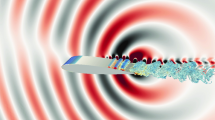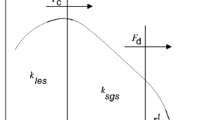Abstract
In this study a detached eddy simulation (DES) model, which belongs to the group of hybrid URANS/LES turbulence models, is used for the simulation of vortex shedding behind a triangular obstacle. In the near wall region or in regions where the grid resolution is not sufficiently fine to resolve smaller structures, the two-equation RANS shear-stress transport (SST) model is used. In the other regions with higher grid resolution a LES model, which uses a transport equation for the turbulent subgrid energy, is applied. The DES model is first investigated for two standard test cases, namely decaying homogeneous isotropic turbulence and the backward facing step, respectively. For the decaying homogeneous isotropic turbulence test case the evolution of the energy spectra in wavenumber space for different times are studied for both the DES and a Smagorinsky type LES model. Different grid resolutions are analyzed with a special emphasis on the modeling constant connecting the filter length scale to the grid size. The results are compared to experimental data. The backward facing step test case is used to study the model behavior for a case with a transition region between a RANS modeling approach close to the wall and LES based modeling in the intense shear flow region. The final application is the simulation of the vortex shedding behind a triangular obstacle. First, the influence of the inlet condition formulation is studied in detail as they can have a significant influence especially for LES based models. Detailed comparisons between simulation and experiment for the flow structure past the obstacle and statistical quantities such as the shedding frequency are shown. Finally the additional temporal and spatial information provided by the DES model is used to show the predicted anisotropy of turbulence.
Similar content being viewed by others
References
Barth, T.J., Jesperson, D.C.: The design and application of upwind schemes on unstructured meshes. AIAA Pap. (89–0366) (1989)
Batten, P., Goldberg, U., Chakravarthy, S.: Interfacing statistical turbulence closures with Large-Eddy simulation. AIAA J. 42(3), 485–492 (2004)
Boughanem, H.: Évaluation des termes de transport et de dissipation de surface de flamme par simulation numerique directe de la combustion turbulente. Ph.D. thesis, Université de Rouen (1998)
Comte-Bellot, G., Corrsin, S.: Simple Eulerian time correlation of full- and narrow-band velocity signals in grid-generated ’Isotropic’ turbulence. J. Fluid Mech. 48, 273–337 (1971)
Constantinescu, G.S., Squires, K.D.: LES and DES investigations of turbulent flow over a sphere at Re=10,000. Flow Turbul. Combust. 70, 267–298 (2003)
Davidson, L., Dahlström, S.: An approach to make LES applicable at high Reynolds number. In: de Vahl Davis, G., Leonardi, E. (eds.) CHT-04: Advances in Computational Heat Transfer III. Begell House, New York (2004)
Hamed, A., Basu, D., Das, K.: Assessment of hybrid turbulence models for unsteady high speed separated flow predictions. AIAA-2004-0684 (2004)
Hanjalić, K., Hadz̆iabdić, M., Temmerman, L., Leschziner, M.A.: Merging LES and RANS strategies: zonal or seamless coupling? In: ERCOFTAC Series: Direct and Large-Eddy Simulation, vol. 5, pp. 451–464. Kluwer Academic, The Netherlands (2004)
Johansson, S.H., Davidson, L., Olsson, E.: Numerical simulation of vortex shedding past triangular cylinders at high Reynolds number using k-ε turbulence model. Int. J. Numer. Methods Fluids 16, 859–878 (1993)
Jones, W.P., Launder, B.E.: The prediction of laminarization with a two-equation model of turbulence. Int. J. Heat Mass Transfer 15, 301–314 (1972)
Jovanovic, J.: The Statistical Dynamics of Turbulence. Springer, Heidelberg (2002)
Jovic, S., Driver, D.M.: Backward-facing step measurement at low Reynolds number, Re = 5000. NASA Tech. Memo. (108807) (1994)
Kapadia, S., Roy, S., Vallero, M., Wurtzler, K., Frosythe, J.: Detached-Eddy simulation over a reference Ahmed car model. In: ERCOFTAC Series: Direct and Large-Eddy Simulation, vol. 5, pp. 481–488 (2004)
Launder, B.E., Sharma, B.I.: Application of the energy-dissipation model of turbulence to the calculation of flow near a spinning disc. Lett. Heat Mass Transf. 1, 131–138 (1974)
Le, H., Moin, P., Kim, J.: Direct numerical simulation of turbulent flow over a backward-facing step. J. Fluid. Mech. 330, 349–374 (1997)
Menter, F.R.: Zonal two-equation k-ω turbulence models for aerodynamic flows. AIAA Pap. (1993–2906) (1993)
Pope, S.: Turbulent Flows. Cambridge University Press, Cambridge (2000)
Shur, M.L., Spalart, P.R., Strelets, M., Travin, A.K.: Navier–Stokes simulation of shedding turbulent flow past a circular cylinder and a cylinder with backward splitter plate. Third Eur. CFD Conf., Paris (1996)
Sjunnesson, A., Nelsson, C., Erland, M.: LDA measurements of velocities and turbulence in a bluff body stabilized flame. NUTEK Report, (89-4195P) (1991)
Smagorinsky, J.: General circulation experiments with the primitive equations: I. The basic equations. Mon. Weather Rev. 91, 99–164 (1963)
Spalart, P.R.: Young Person’s Guide to Detached Eddy Simulation Grids. NASA (CR-2001-211032), Hampton (2001)
Spalart, P.R., Allmaras, S.R.: A one-equation turbulence model for aerodynamic flows. La Recherche Aerospatiale 1, 5–21 (1994)
Spalart, P.R., Jou., W.-H., Strelets, M., Allmaras, R.: Comments on the feasibility of LES for wings, and on a hybrid RANS/LES approach. In: Liu, C., Liu, Z. (eds.) Advances in DNS/LES. 1st AFOSR Int. Conf. on DNS/LES 1997, Ruston, LA. Greyden, Columbus, OH (1997)
Squires, K.D.: Detached-Eddy simulation: current status and perspectives. In: ERCOFTAC Series: Direct and Large-Eddy Simulation, vol. 5, pp. 465–480 (2004)
Strelets, M.: Detached Eddy simulation of massively separated flows. AIAA Pap. (2001–0879) (2001)
Temmerman, L., Hadz̆iabdić, M., Leschziner, M.A., Hanjalić, K.: A hybrid two-layer URANS-LES approach for large Eddy simulation at high Reynolds numbers. Int. J. Heat Fluid Flow 26, 173–190 (2005)
Travin, A., Shur, M., Strelets, M., Spalart, P.R.: Physical and numerical upgrades in the detached-Eddy simulation of complex turbulent flux flows. In: Friedrich R., Rodi, W. (eds.) Fluid Dynamics and Its Applications. Advances in LES of Complex Flows. Proc. of EUROMECH colloquium, vol. 412, no. 65, pp.239–254. Kluwer Academic, Dordrecht (2002)
Wilcox, D.C.: Turbulence Modeling for CFD. DCW Industries, California (1993)
Author information
Authors and Affiliations
Corresponding author
Rights and permissions
About this article
Cite this article
Hasse, C., Sohm, V., Wetzel, M. et al. Hybrid URANS/LES Turbulence Simulation of Vortex Shedding Behind a Triangular Flameholder. Flow Turbulence Combust 83, 1–20 (2009). https://doi.org/10.1007/s10494-008-9186-7
Received:
Accepted:
Published:
Issue Date:
DOI: https://doi.org/10.1007/s10494-008-9186-7




